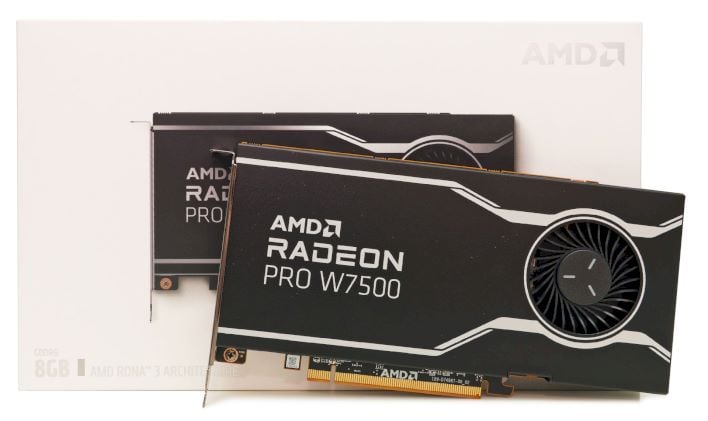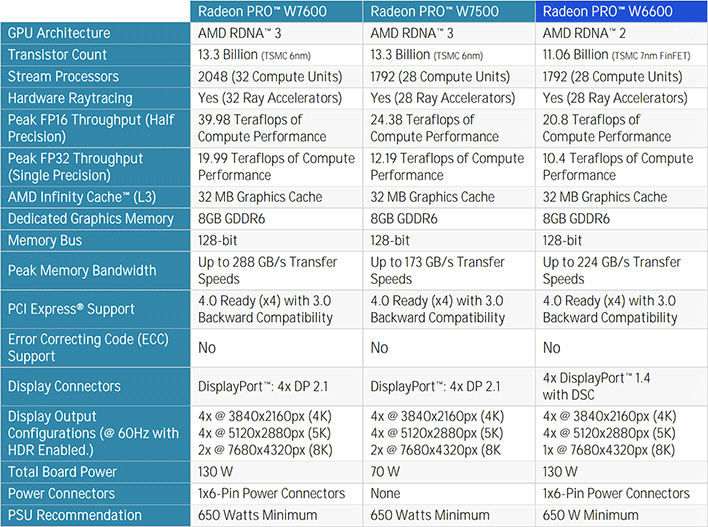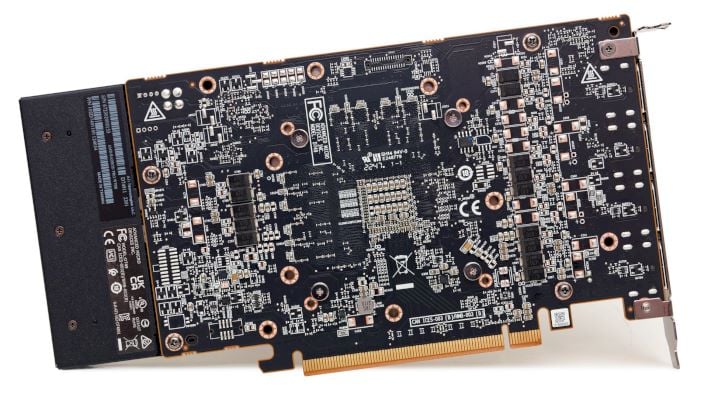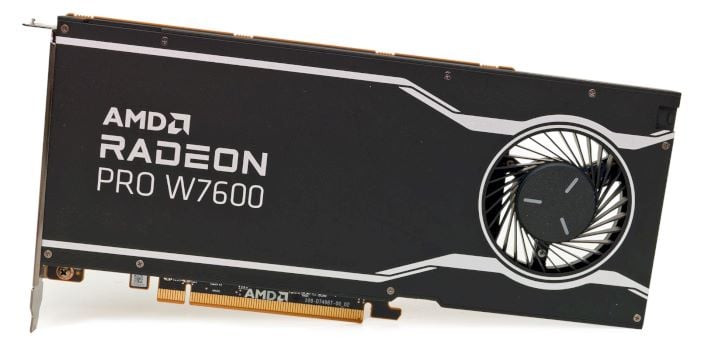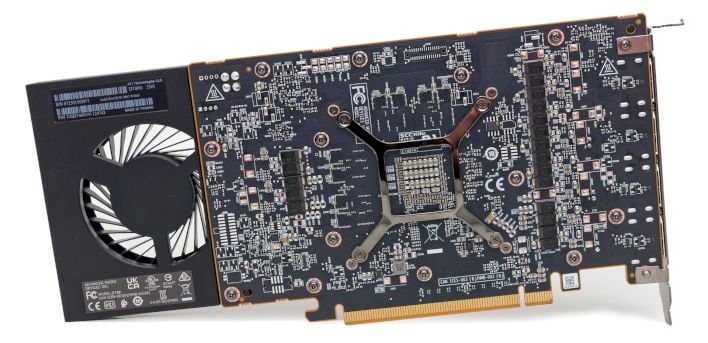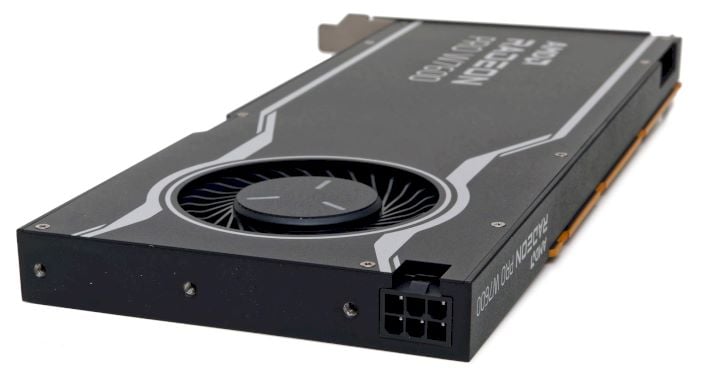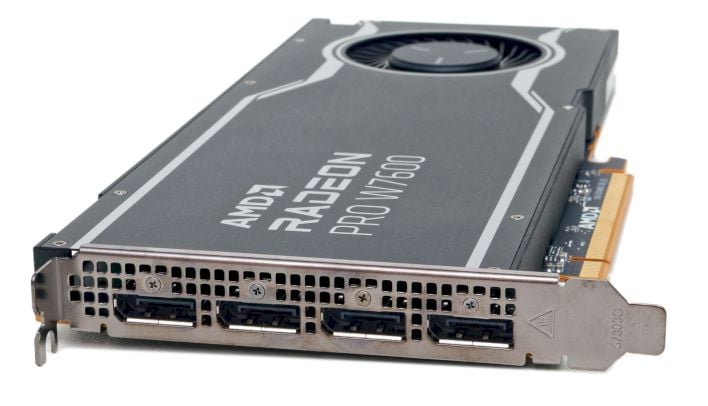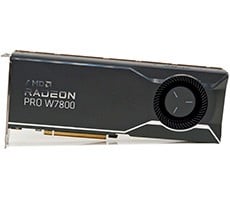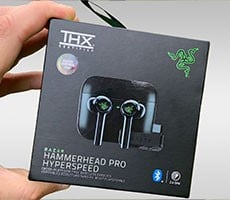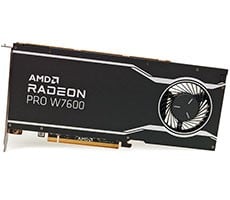AMD Radeon Pro W7600 And W7500 Review: Value-Driven Pro-Vis Graphics
| AMD Radeon Pro W7600 & W7500: SEP $429 (W7500), $599 (W7600) The new Radeon Pro W7600 and W7500 are affordable single-slot, low-power RDNA3-based professional workstation GPUs for content creators and graphics pros.
|
|||

|

|
||
A couple of things happened a few months back that set the stage for today’s launch of the Radeon Pro W7600 and Radeon Pro W7500. First, AMD announced the top-of-the-line Radeon Pro W7900 and W7800 with 48GB and 32GB of memory, respectively. The Radeon RX 7600, based on the scaled-down Navi 33 GPU, also hit the scene. The Radeon Pro W7600 and W7500 do share some DNA with those products. The Radeon Pro W7600 and W7500 expand AMD’s 7000-series Radeon Pro family to complement the high-end W7900 and W7800, but they feature the same Navi 33 GPU as the consumer-class Radeon RX 7600.
As you’d expect, the Radeon Pro W7600 and W7500 target completely different market segments than their high-end counterparts. These more attainable professional graphics cards are destined for mainstream workstations where massive amounts of memory and compute horsepower aren’t an absolute necessity, but the ISV certifications and stability of a pro-vis GPU are a must. Let’s check them out...
AMD Radeon Pro W7600 And W7500 Features & Specifications
Although they are built around the same GPU, the Radeon Pro W7600 And W7500 are quite different overall. Versus the previous-gen Radeon Pro W6600, the cards are upgrades nearly across the board (the W7600 is a significant upgrade), but there are some significant differences.
As mentioned, the Radeon Pro W7600 and W7500 are based on the Navi 33 GPU, which features up to 32 Compute Units (CUs) with a total of 2,048 cores, up to 32 Ray Accelerators, and 32MB of Infinity Cache. The W7600 makes use of the full Navi 33 configuration, but the W7500 is pared down somewhat. The GPU on the Radeon Pro W7500 packs 28 CUs with 1,792 cores, 28 Ray Accelerators, but the same 32MB of Infinity Cache. Both cards share the same PCIe Gen 4 x4 interface and 8GB of GDDR6 memory, linked to the GPU via a 128-bit memory bus. The Radeon Pro W7600’s memory is clocked much faster though. The W7600’s memory operates at an effective data rate of 18Gbps, whereas the W7500 skips along at much lower 11Gbps. We asked why AMD was using relatively low-speed memory on the W7500 and were told it was mostly for power considerations.
At those speeds, the Radeon Pro W7600 offers peak memory bandwidth of 288GB/s, which is a nice step up from the previous-gen W6600’s 224GB/s. The W7500 can only muster 173GB/s, however, which holds in back in a number of benchmarks. As you’ll see in a bit, despite offering more theoretical peak compute performance than the Radeon Pro W6600, the Radeon Pro W7500 trails its predecessor in a number of tests. That is NOT the case with the Radeon Pro W7600, though.
The Radeon Pro W7600 offers peak half-precision FP16 throughput of 39.98 Teraflops (19.99 Teraflops peak FP32 single precision), while the Radeon Pro W7500 clocks in at 24.38 Teraflops at FP16 and 12.19 Teraflops at FP32. And because they're based on AMD's latest GPU architecture, the Radeon Pro W7600 and W7500 both offer the company's latest media engines with hardware accelerated AV1 encode/decode, along with all of the goodies from previous generations.
Inspecting The Radeon Pro W7600 And W7500
In terms of their physical dimensions, the Radeon Pro W7600 and W7500 resemble previous-gen Radeon Pro cards. They have similar boxy, blower-style coolers and roughly the height, though the W7x00 series cards are ½ inch longer (11” vs. 10.5”).Underneath their fan shrouds, there is a dense array of heatsink fins that sit directly atop the GPUs and RAM, with a barrel-type fan offset towards the back of the card. Their fan shrouds are actually much longer than the PCBs on each card, and extend off the rear by a few inches. The entire assembly is relatively small and slim though, and the Radeon Pro W7600 AND W7500 requires only a single slot. The W7600’s cooling fan, however, does pass all the way through the cooler, whereas the W7500’s does not.
Of course their color scheme is completely different. The beautiful YInMn Blue that adorned Radeon Pro cards for the last few generations is gone, in favor of a no-nonsense black and grey aesthetic. The cards still look cool, but we will miss that unique blue.
The Radeon Pro W7600 features a single 6-pin PCIe power feed, which provides plenty of power headroom for card. Between the PCIe slot and the supplemental feed, 150W will be available to the Radeon Pro W7600 AND W7500 (75 + 75), which is 20W higher than its 130W max board power rating. The 70W Radeon Pro W7500 does not require supplemental power – it is completely powered by its slot.
The display outputs on the Radeon Pro W7600 and W7500 consist of 4, full-sized DisplayPort 2.1 ports with UHBR 10 support offering a maximum of 38.7Gbit/s across 4 lanes. All of the display outputs on the cards can be used at any given time for multi-monitor configurations, consisting of up to 4 x 4K, 4 x 5K, or 2 x 8K displays. The remainder of the case bracket features square-shaped vent holes, for exhausting warm air out of the system.
And with all of that out of the way, it time to get these cards installed into the test rig and see how they perform...

